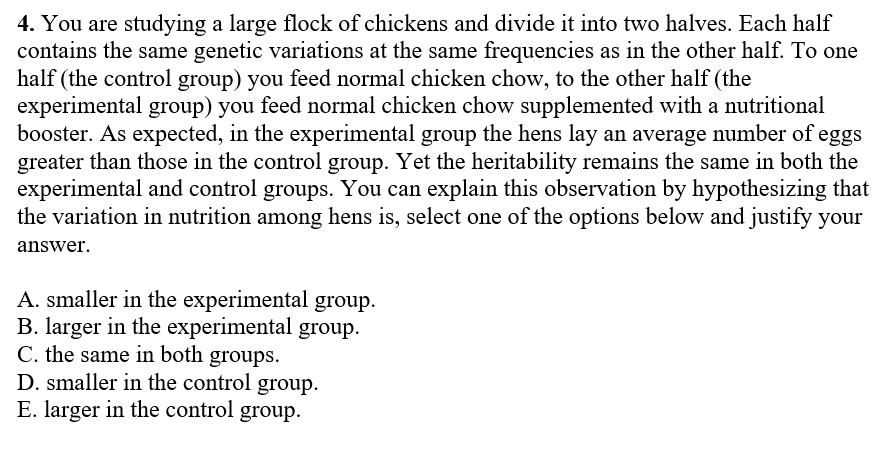4. You are studying a large flock of chickens and divide it into two halves. Each half contains the same genetic variations at the same frequencies as in the other half. To one half (the control group) you feed normal chicken chow, to the other half (the experimental group) you feed normal chicken chow supplemented with a nutritional booster. As expected, in the experimental group the hens lay an average number of eggs greater than those in the control group. Yet the heritability remains the same in both the experimental and control groups. You can explain this observation by hypothesizing that the variation in nutrition among hens is, select one of the options below and justify your answer. A. smaller in the experimental group. B. larger in the experimental group. C. the same in both groups. D. smaller in the control group. E. larger in the control group.
4. You are studying a large flock of chickens and divide it into two halves. Each half contains the same genetic variations at the same frequencies as in the other half. To one half (the control group) you feed normal chicken chow, to the other half (the experimental group) you feed normal chicken chow supplemented with a nutritional booster. As expected, in the experimental group the hens lay an average number of eggs greater than those in the control group. Yet the heritability remains the same in both the experimental and control groups. You can explain this observation by hypothesizing that the variation in nutrition among hens is, select one of the options below and justify your answer. A. smaller in the experimental group. B. larger in the experimental group. C. the same in both groups. D. smaller in the control group. E. larger in the control group.
Biology: The Dynamic Science (MindTap Course List)
4th Edition
ISBN:9781305389892
Author:Peter J. Russell, Paul E. Hertz, Beverly McMillan
Publisher:Peter J. Russell, Paul E. Hertz, Beverly McMillan
Chapter21: Microevolution: Genetic Changes Within Populations
Section: Chapter Questions
Problem 1TYK: The reason spontaneous mutations do not have an immediate effect on allele frequencies in a large...
Related questions
Question

Transcribed Image Text:4. You are studying a large flock of chickens and divide it into two halves. Each half
contains the same genetic variations at the same frequencies as in the other half. To one
half (the control group) you feed normal chicken chow, to the other half (the
experimental group) you feed normal chicken chow supplemented with a nutritional
booster. As expected, in the experimental group the hens lay an average number of eggs
greater than those in the control group. Yet the heritability remains the same in both the
experimental and control groups. You can explain this observation by hypothesizing that
the variation in nutrition among hens is, select one of the options below and justify your
answer.
A. smaller in the experimental group.
B. larger in the experimental group.
C. the same in both groups.
D. smaller in the control group.
E. larger in the control group.
Expert Solution
This question has been solved!
Explore an expertly crafted, step-by-step solution for a thorough understanding of key concepts.
This is a popular solution!
Trending now
This is a popular solution!
Step by step
Solved in 2 steps

Recommended textbooks for you

Biology: The Dynamic Science (MindTap Course List)
Biology
ISBN:
9781305389892
Author:
Peter J. Russell, Paul E. Hertz, Beverly McMillan
Publisher:
Cengage Learning

Biology 2e
Biology
ISBN:
9781947172517
Author:
Matthew Douglas, Jung Choi, Mary Ann Clark
Publisher:
OpenStax

Biology: The Unity and Diversity of Life (MindTap…
Biology
ISBN:
9781337408332
Author:
Cecie Starr, Ralph Taggart, Christine Evers, Lisa Starr
Publisher:
Cengage Learning

Biology: The Dynamic Science (MindTap Course List)
Biology
ISBN:
9781305389892
Author:
Peter J. Russell, Paul E. Hertz, Beverly McMillan
Publisher:
Cengage Learning

Biology 2e
Biology
ISBN:
9781947172517
Author:
Matthew Douglas, Jung Choi, Mary Ann Clark
Publisher:
OpenStax

Biology: The Unity and Diversity of Life (MindTap…
Biology
ISBN:
9781337408332
Author:
Cecie Starr, Ralph Taggart, Christine Evers, Lisa Starr
Publisher:
Cengage Learning

Biology: The Unity and Diversity of Life (MindTap…
Biology
ISBN:
9781305073951
Author:
Cecie Starr, Ralph Taggart, Christine Evers, Lisa Starr
Publisher:
Cengage Learning